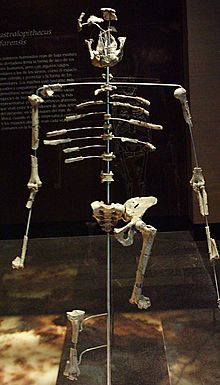Lucy (Australopithecus) facts for kids
 |
|
| Catalog number | AL 288-1 |
|---|---|
| Common name | Lucy |
| Species | Australopithecus afarensis |
| Age | 3.2 million years |
| Place discovered | Afar Depression, Ethiopia |
| Date discovered | November 24, 1974 |
| Discovered by | Johanson and Gray |
Lucy is the famous common name for a very important fossil discovery. Her scientific name is AL 288-1. She is about 40% of the skeleton of a female Australopithecus afarensis. Scientists found several hundred pieces of her bones. This amazing discovery happened in 1974 in a place called Hadar. This area is in the Awash Valley of Ethiopia's Afar Depression.
Lucy lived about 3.2 million years ago. She is a type of early human ancestor known as a hominid. Her skeleton gave scientists a lot of important clues about how early humans lived.
Discovery of Lucy
The discovery of Lucy happened on November 24, 1974. A team of scientists was working in the Afar Depression in Ethiopia. The team was led by Donald Johanson. One day, Johanson and his student, Tom Gray, found a small arm bone. They soon realized it was part of a much larger skeleton.
They spent days carefully digging up more bones. They found parts of a skull, jaw, ribs, arm, leg, and pelvis. Finding so many bones from one individual was very rare. This made Lucy one of the most complete early human skeletons ever found.
Who Was Lucy?
Lucy belongs to a species called Australopithecus afarensis. This name means "southern ape from Afar." She was an adult female, but she was quite small. She stood about 3.5 feet (1.1 meters) tall and weighed around 60 pounds (27 kg).
Scientists can tell a lot about her from her bones. For example, her teeth show she ate mostly plants. Her bones also tell us she was fully grown when she died.
Why Lucy is Important
Lucy's skeleton showed scientists two very important things. First, she had a small skull, much like an ape. This means her brain size was similar to an ape's. Second, her leg bones and pelvis clearly showed that she walked upright. This is called bipedalism.
This discovery was a huge deal for understanding human evolution. Before Lucy, some scientists thought that a big brain developed first, and then humans started walking upright. But Lucy showed the opposite! She proved that walking on two legs came before a large increase in brain size. This feature is true for all australopithecines. Lucy helped us understand a key step in our human journey.
Images for kids
-
Lucy skeleton reconstruction at the Cleveland Museum of Natural History
See also
 In Spanish: Lucy para niños
In Spanish: Lucy para niños




